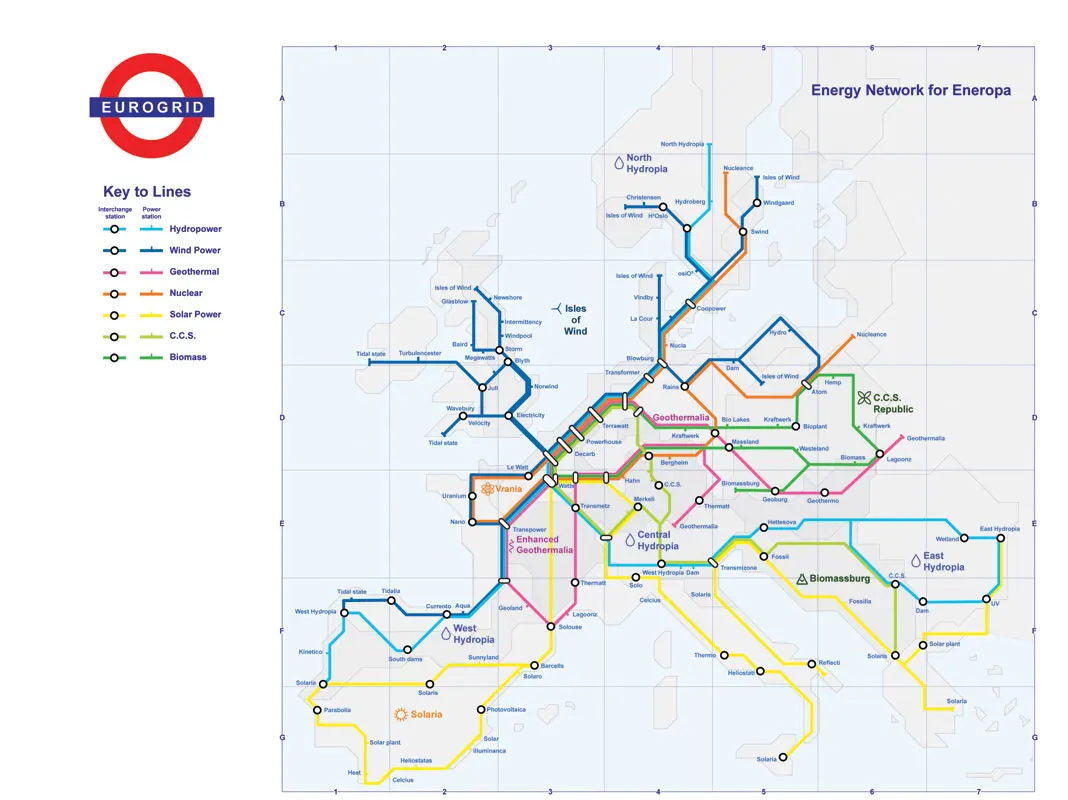
We have known for decades now that the future energy mix will be based on renewables, and the key to a sustainable future is the electric grid. Buckminster Fuller proposed a global electric grid in the 1930s and worked on the project for several decades. Since the early 2000s, OMA - Office for Metropolitan Architecture - has been developing scenarios for the European electric grid, where the Mediterranean countries supply solar energy and the Northern countries wind. The latest rendition of this idea is Eneuropa, again by AMO (the research arm of OMA), with McKinsey, Imperial College London, energy consultancy KEMA and analyst Oxford Economics. On the right is a portion of the map, where the UK spans between the Isles of Wind and the Tidal States. The most important and costly investment to implement this plan is a new long-range and powerful electric grid.
‘The power sector requires the most aggressive change,’ says AMO project director Laura Baird. Roadmap 2050 proposes a European supergrid where UK winds and tides, Mediterranean sunshine and central European forests work together to reduce Europe’s reliance on fossil fuels.

The main idea is that large-scale, efficient grids will reduce the intermittency issues tied to renewables (the sun is always shining somewhere). We could and should make the same reasoning in the UK. To contribute and take advantage of the European grid, we must build our own and maximise the richness of our renewable production.
In fact, large amounts of renewable energy are wasted yearly because of how the grid is built. This map illustrates the break between the Northern and Southern grids. Most renewable energy providers are in Scotland and Northern England, which does not consume all of it. On particularly windy days, energy from Scotland and the North could supply almost all the power we need. However, delivering this power where needed is impossible because of the lack of transmission lines between the energy-productive North and the energy-hungry South. So when the output is too high, the energy grid needs to pay wind farm owners to stop the turbines to avoid overloading the grid.

According to this perfect article by Archy de Bercker, curtailment costs us about 1 Billion(!) in fees and wasted energy. The government is planning new transmission lines and faces much resistance and NIMBY-ism. Therefore the largest transmission lines are planned on the sea bed and will take years to build. While building the transmission lines, the Scottish renewable energy output will increase further, making even the new lines obsolete.
Simply put: we can’t lay cables fast enough to solve this problem.
According to Archy de Bercker, the ideal solution would be a more diffused grid: with several connection points. Again, this would require overcoming a lot of resistance. Local and national governments need all the possible support to design the new lines properly by involving and informing the citizens about the knowledge on upgrading the grid. But there are also other options: Other means of making the most of otherwise wasted energy would be to deploy battery storage on the energy-abundant side of the divide. Batteries can be deployed at large or small scale. Heat batteries can always draw electricity to recharge, especially at night when there is often too much output (and energy is cheaper). These products are designed precisely to take advantage of the low-cost energy to provide:
I. a service to the grid that needs a way of balancing before getting overloaded;
II. A way to avoid wasting energy through curtailment;
III. Lower bills for its owners
For these reasons, we have included them among our recommended solutions to electrify our homes and replace gas boilers. Instead of wasting one billion pounds a year, we could invest in incentivising the installation of heat energy batteries to replace boilers, especially in areas where power goes wasted: Scotland and Northern England.
To find the best for you on a free-pro-bono website built by environmental activists and architects, check out www.nomoregas.org.
Read more about this:
